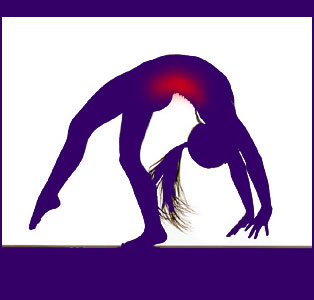
Gymnastics back pain is a very common occurrence for serious gymnasts and former gymnastic competitors to experience. Gymnasts are statistically disposed towards a high risk for spinal injury and accelerated structural degeneration. Over the past decade, we have received a tremendous amount of reader correspondence from gymnastic participants and have therefore thought it time to include the topic in its own dedicated article.
Gymnastics builds tremendous strength and flexibility in the anatomy. There is no doubt that gymnasts are some of the finest conditioned of all athletes. Gymnasts face a continual threat of injury and usually suffer many physical setbacks during their careers. This recurrent trauma to the muscles, ligaments tendons and skeleton can all lead to the development of back or neck pain due to a great diversity of causative mechanisms.
This essay examines gymnastics back pain in athletes. We will look at the reasons why these athletes suffer such a common incidence of dorsalgia, as well as what can be done to minimize the risks associated with gymnastic participation. Finally, we will provide some treatment advice for patients who already demonstrate severe back and spine symptoms related to gymnastics.
Gymnastics Back Pain Due to Injury
Gymnasts place tremendous stress on their bodies as a normal part of training and competition. Although they do everything to condition their bodies to be strong and flexible through an exhaustive regimen of exercise and stretching, the possibility for injury is ever-present in the gymnastics world.
Injuries can happen at any point in the training process, from warm-up exercises to the rigors of competition itself. Furthermore, injuries can be acute catastrophes or may simply be slow-developing conditions that result from continual recurrent stress on bodily tissues. Below are listed many of the common injurious circumstances that affect gymnasts during their careers:
Muscular, ligamentous and tendon injury is commonplace and most serious gymnasts will suffer multiple types of soft tissue traumas during their active years of participation. Most of these injuries will heal well, given time and possible rehabilitative care. Severe muscular injuries might require surgical correction, especially in cases of torn or detached tissues. Some soft tissue problems might leave lasting negative consequences that may cause or contribute to the origination of chronic back or neck pain. RSI is a common diagnosis within the gymnastics industry, since many traumas are produced by repetitive stress on the same tissues year in and year out.
Spinal injuries span the full possible range of diagnoses, including vertebral fractures and intervertebral herniation. Broken vertebrae may or may not require professional medical care, but should always be evaluated by a qualified sports medicine physician. Acute herniated discs may or may not be painful, but even severely symptomatic herniations will usually resolve without lasting effects on functionality.
Shocks to the spine may cause rare instances of vertebral listhesis, especially if the gymnast demonstrates a spondylolysis defect at the affected vertebral levels.
Severe spinal traumas might also create transient or permanent changes to the front-to-back curvatures of the backbone, potentially creating hypolordotic, hyperlordotic, hypokyphotic or hyperkyphotic conditions in the cervical, thoracic, or lumbar regions.
Gymnastics Back Pain Due to Degeneration
Even when devoid of acute traumatic injury, the very nature of gymnastic participation involves tremendous stress on the anatomy. Over many years, these pressures are well known to lead to escalated and early-onset degenerative changes to the spine in virtually all gymnasts.
While typical spinal deterioration is usually asymptomatic, truly extreme examples of spinal wear and tear may actually become pathological and may therefore be linked to the development of back or neck pain, as well as related neurological expressions. Some of the more common types of degenerative processes that may be worsened by gymnastics include:
Degenerative disc disease is a virtually universal finding in the general population and is typically found in more severe degrees in the spines of gymnasts. Furthermore, while mid to low cervical disc degeneration and lower lumbar disc desiccation is expected in most people, many young gymnasts experience intervertebral deterioration at many other spinal locations, since they are called upon to bend and flex the entire backbones more than the general population.
Spinal osteoarthritis is often found in late teenage gymnasts, decades before it is universally found in the general population. The constant stresses on the spine are known to exacerbate the aging processes that affect every vertebral bone and spinal joint, leading to the accelerated and exaggerated growth of osteophytes, as well as the similarly worsened breakdown of the protective measures, such as a loss of synovial fluid in the spinal structures.
Recurrent trauma due to minor injury can hasten and escalate the normal, general degenerative processes, leading to advanced forms of spinal aging at younger ages.
Gymnastics Pain Prevention
Although gymnastics does involve inherent risk to the spine, there are some practices that can mitigate the hazards associated with regular, high-intensity training and competitive exertions:
Techniques should be fully understood before ever being attempted. Many gymnasts are injured during the learning process for new routines and skills. Coaches must understand the increased risk of the learning process and do everything possible to protect their students while they mature technically.
Proper safety equipment should always be utilized to protect gymnasts. Special care should be taken to reduce impacts, to spot all techniques and to make sure that all apparatus are in perfect working condition.
Proper warm-up and stretching must be part of every workout. Proper cool down and conditioning work should be part of every end session. Care should be taken to minimize hyperextension and hyperflexion of the spine.
Serious gymnasts should benefit from expert coaches or sports psychologists who can help them to create a healthy psychoemotional state for competition. The mental strain of the sport can be the actual cause of mindbody pain syndromes and can also increase internal tension in muscles and connective tissues, enhancing the odds of suffering actual anatomical injury. All of these practices will help prevent the occurrence of gymnastics back pain.
Gymnastics Back Pain Treatment
Anatomical damage should always be evaluated and diagnosed by experts in sports medicine. These doctors are uniquely qualified to relate bodily injury to its specific athletic cause. This is crucial knowledge to help guide patients towards safer participation in their beloved events, without repeating the same scenarios that led to the previous injury.
Most muscular concerns do not require drastic or invasive intervention, but may require some form of physical therapy to fully resolve. Some soft tissue problems that cause gymnastics back pain might require more aggressive treatment, such as reparative surgery, but this is not overly common, especially in younger gymnasts.
Spinal injury may or may not require therapy. Some fractures only need monitoring, while most intervertebral protrusions do not need any special care. However, both should always be monitored and some cases may require treatment if they compromise the integrity of the spinal nerve tissues or the central spinal cord.
If any treatment is required for injury, the gymnast should once again seek out a specialist in sports medicine in order to increase their chances of continuing their competitive career once fully rehabilitated.
Spinal degeneration is a more complicated issue, since many cases may be advanced for the patient’s age, but might still not require any particular attention, except regular monitoring. Spinal arthritis and intervertebral desiccation are both universal and are rarely pathological, even when the changes are severe. However, in rare circumstances, these conditions can be symptomatic, thwarting the neurological integrity of the spinal tissues and possibly eliciting horrific symptoms in some patients. We usually recommend consulting with a very conservative sports-focused neurologist for treatment advice, since these cases must be evaluated on an individual basis.
Mindbody pain syndromes are typically found in high-pressure competitive athletes. Gymnasts are certainly no exceptions to this guideline. Many high level gymnastics practitioners use knowledge therapy techniques to overcome the psychological issues creating pain and limited functionality. Coaching is another useful tool that can help to keep gymnasts performing up to their highest level, while minimizing the negative effects of damaging mindbody nocebo.





